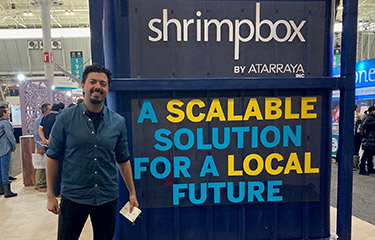Mexico City, Mexico-based Atarraya, the creator of the Shrimpbox portable shrimp-farming system, is seeking USD 25 million (EUR 22.7 million) in a Series B fundraising round.
Atarraya markets its Shrimpbox – essentially a shipping container that has been converted into a small commercial shrimp farm – as a shrimp-in-a-box systems that allows for economical, low-impact, hyper-local shrimp farming. The company’s U.S. headquarters and its first farm are located in Indianapolis, Indiana, U.S.A. but Russek told SeafoodSource his company is preparing to launch an early-adopter program in niche markets as it seeks to maximize early returns and prove that practically anyone can become a shrimp farmer.
“We have eight units now and we had our first harvest in October 2022. We will finish the year with 40 and by 2024 there will be 400 spread out in different parts of the U.S.,” Russek told SeafoodSource at the 2023 Seafood Expo North America.
Atarraya began fundraising for the new round on 15 March, 2023.
"We already have two solid prospects for leading the round," Russek told Axios.
Atarraya closed a USD 3.9 million (EUR 3.6 million) Series A fundraising round in May 2023, which valued the company at USD 41 million (EUR 37.3 million). The round had participation from big-name angel investors including Jeffrey Horing, Mark Gormley, Geoffrey Kalish, Robert Stavis, and Robert Goodman. Atarraya raised another USD 1.1 million (EUR 1 million) in January 2023.
With the tagline, “bringing farm-to-table shrimp-farming to across-the-street,” Atarraya is aiming to place Shrimpbox farms in urban areas around the U.S. Russek said the eventual goal is to have a Shrimpbox farm in every major U.S. market. The company is preparing to launch an early-adopter program in niche markets as it seeks to maximize early returns and prove its claim that practically anyone can become a shrimp farmer.
The Shrimpbox containers, first introduced for commercial sale in September 2022, are built from scratch in Mexico City. Each Shrimpbox costs USD 50,000 (EUR 45,000), and Russek said a 20-box farm is capable of generating a 20 percent annual return.
“The most-important aspect of Shrimpbox is its ability to expand. We want it to be as easy as running a refrigerator,” Russek told SeafoodSource. “We think that this is this is basically the modern equivalent for shrimp as a chicken coop.”
Atarraya is also offering a leasing program for aspiring farmers, and the company aims to make it easy to get started by providing postlarvae, feed, training, and software that essentially runs the entire biofloc system. Russek told SeafoodSource the Shrimpbox requires minimal water exchange and contains an automated feeding system and biofloc waste-removal system, minimizing the work involved in farming shrimp in the unit while eliminating the need for using antibiotics and chemicals. It also relies on artificial intelligence that can remotely monitor water quality and regulate water temperature and oxygenation. And the shipping-container-sized Shrimpbox can be easily squeezed into smaller urban warehouses and stacked if it’s easier to build volume vertically rather than horizontally.
"Contract farming has been a very successful model at generating rapid expansion of agricultural industries like poultry, and it allows us to focus on creating the infrastructure and managing the platform so that others can hop in. The idea is that everything we do is supporting what is going be this new supply chain of decentralized, independent farmers.”
To ensure quality, Atarraya has automated most farming processes and narrowed down a 90-step shrimp-farming protocol to just seven. It sends out aquafeed to different life stages of the shrimp and has even generated a plan to eventually automate processing at each of its shrimp farms nationally.
“In the beginning, we won't be relying on any kind of expensive processing because our shrimp has a competitive advantage head-on, shell-on, never frozen,” Russek said. “Eventually, we will take the head off, and then we’re working toward peeled and deveined, because that is where we get 10-day shelf-life,” he said. “We know exactly what are the costs involved in that, but for that, we need scale.”
Atarraya has begun sampling its product to high-end seafood distributors, Russek said.
“We’re asking them if they …
Photo courtesy of Cliff White/SeafoodSource








